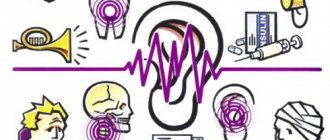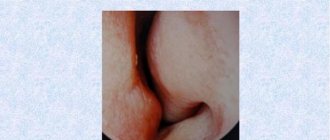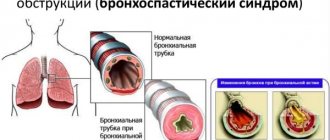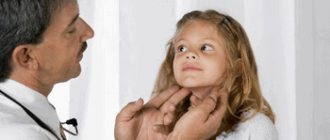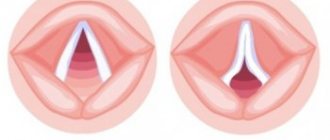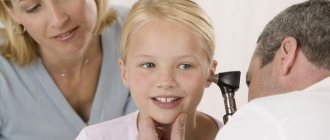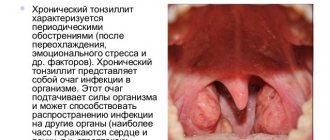Hearing impairment can be represented by two groups of diseases: deafness and hearing loss. According to the World Health Organization (WHO), 5% of the world's population suffers from them. That's 328 million adults and 32 million children. Several reasons lead to deafness, ranging from heredity to inflammatory processes.
Deafness can be congenital or acquired. Some types of it are curable, others, unfortunately, are not. Rehabilitation programs are most successful when deafness is identified in a timely manner and early referral to a specialist.
Deafness and hearing loss: what's the difference?
Different professionals may classify hearing loss differently. In modern Russian practice, it is customary to divide it depending on the range of perceived decibels into:
- Light;
- Average
- Deep (heavy).
With the first two forms they talk about hearing loss , with the last degree - about deafness . Hearing loss can also be unilateral or bilateral. In case of bilateral severe deafness, the patient is assigned disability group III or II.
In practice, these two diseases differ in whether a person is able to distinguish speech addressed to him or not. If a patient cannot hear someone literally shouting in their ear, they have profound hearing loss. The critical threshold for the intensity of perceived sound for hearing loss is 25 dB, for deafness - 80 dB. A separate disease is congenital deaf-muteness, in which a person is unable to perceive sounds at all.
Treatment of hearing loss
Treatment of deafness must begin with the appearance of the initial signs of the disease. When choosing how to treat hearing loss, the doctor takes into account what factors cause its occurrence (poor blood circulation, inflammatory processes as a result of infection, poisoning with toxic substances, traumatic damage to the tissues of the skull). For hearing loss caused by vascular disorders, Cavinton, Cinnarizine, Complamin, Mildronate, Cerebrolysin are prescribed. Additionally, medications are prescribed to normalize blood pressure, cholesterol and sugar levels.
To treat hearing loss caused by infection or exposure to toxic substances, corticosteroids and toxin-neutralizing agents are used - Prednisolone, Hemodez. Nimesulide helps relieve the inflammatory process, and improves microcirculation in tissues - Cocarboxylase, Trental. In the treatment of hearing loss, the development of which occurred after a head injury, Cavinton, Complamin, Nootropil are used. These medications improve blood circulation and cellular metabolism.
In the chronic form of sensorineural deafness, treatment with medications is combined with physiotherapeutic procedures. Conservative therapy is not always able to eliminate tissue disorders that occur in severe stages of the disease. In these cases, it is necessary to treat deafness surgically. Surgical treatment is also indicated for conductive hearing loss. To eliminate temporary deafness, for example, if one ear is deaf, breathing exercises, massage, and acupuncture are additionally used.
Speech therapists work with children with congenital hearing loss; if necessary, children are taught sign language. After consulting with your doctor in advance, you can practice treating deafness with folk remedies, using recipes using garlic, propolis, eleutherococcus, and bay leaves. Folk remedies in combination with conservative therapy can improve hearing in mild forms of hearing loss.
Methods of surgical treatment
Myringoplasty is used to restore the integrity of a damaged eardrum. If it is necessary to replace the auditory ossicles, prostheses made of synthetic material are installed (tympanoplasty). These operations can successfully restore hearing in case of conductive hearing loss. How to treat severe sensorineural deafness: if the hair cells of the organ of Corti are not affected, a hearing aid is installed, otherwise hearing can only be restored with the help of a cochlear implant. This type of treatment for deafness is complex and expensive, but it can help people with the most severe degrees of pathology, including those to whom the disease has been inherited and those with disabilities.
Causes of deafness
Deafness can be due to two main types of causes:
- Impaired sound conduction, i.e. problems in the part of the nervous system that is responsible for transmitting signals from the ear to the brain. This type of deafness is called conductive deafness.
- Impaired sound perception. Behind these pathologies are problems directly related to the auditory analyzer (the ear and the nerves located in it). In this case, the disease is called sensorineural or sensorineural hearing loss.
Causes of deafness can also be:
- Congenital;
- Acquired.
The first group includes:
- Fetal hypoxia during pregnancy and at birth.
- Jaundice in the neonatal period.
- Some diseases suffered by the mother during pregnancy, in particular syphilis, rubella.
- Hereditary diseases cause hearing impairment in approximately 30% of cases. At the moment, about a hundred deafness genes have been discovered, which can be located on any of the non-sex chromosomes.
- Taking drugs with ototoxic effects by the mother during pregnancy.
Acquired deafness can develop as a result of the following factors:
- Inflammatory diseases of the ear - otitis.
- Taking drugs with ototoxic effects.
- Injuries, presence of foreign objects in the ear canal.
- Prolonged exposure to noise. The threshold for such sound radiation is 70-75 dB and 4000 Hz.
- Disruption of the nerve cells of the auditory canals due to age-related changes.
How do people hear
A person's ability to hear depends on a sequence of events that occur in the hearing organs of adults and children, during which airborne sound waves are converted into electrical signals. This happens according to the following scheme:
- Airborne sound vibrations are captured by the ears, and moving along the external auditory canal, they rest against the eardrum.
- Under the influence of waves, the eardrum begins to vibrate and transmit vibrations to three small bones that are located in the cavity of the middle ear. These bones are called the malleus, incus and stapes.
- The three-bone system is an acoustic amplifier for sound signals. When the sound of air vibrations passes through this system, it is amplified and transmitted to the cochlea of the inner ear, which is characterized by a spiral shape. Inside the snail is filled with liquid, which vibrates under the influence of vibrations that were transmitted to it through the bones. An elastic membrane passes through the entire cochlea, dividing it into upper and lower parts. This membrane is called the basilar membrane.
- After the vibrations cause the fluid inside the cochlea to vibrate, a wave of fluid begins to travel along the basilar membrane. The ciliated cells on its surface begin to vibrate in accordance with the wave vibrations.
- Microscopic projections on the surface of cells, called cilia, hit an overhanging structure as they vibrate and bend. Bending the cilia causes porous micro-channels to open. When this happens, a chemical enters the channels and an electrical signal is generated.
- The auditory nerve conducts electrical signals to the brain, which transforms it into a form understandable to human consciousness.
The International Classification of Hearing Disorders refers to diseases of the ear and mastoid process. According to ICD-10 code: H90 – H90.5. There are two types of hearing impairment. The first is conductive or conductive hearing loss, when hearing loss occurs due to obstacles in the path of sound. For example, the cause of hearing loss may be cerumen or inflammation of the middle ear. In this case, the cause can be corrected, and after treatment the ability to perceive sounds will return.
The second type is sensorineural hearing loss, which is characterized by damage to the cochlea or auditory nerve. In this case, the loss of hearing is irreversible and may result in complete deafness, and the person will be given a hearing disability.
Many factors influence the deterioration of hearing ability, and the causes of hearing deterioration can be very different. Causes that can lead to hearing loss associated with aging can be difficult to distinguish from hearing loss that occurs, for example, under the influence of loud sounds.
Acoustic trauma is a very common cause of hearing loss. In this case, hearing loss occurs either from the influence of sounds that are too loud, or from exposure to sounds for too long. Acoustic trauma can destroy sensory ciliated cells in the inner ear, which play a major role in hearing. When these cells are damaged, the cilia do not recover, and permanent hearing impairment occurs. Prevention of hearing impairment involves measures to prevent the influence of loud sounds.
Diagnostic methods used in audiology
The first step of the doctor is to collect the patient's medical history. Therefore, even if the specialist does not ask all the necessary questions, at the appointment it is important to pay attention to the following signs of deafness:
- Inflammatory diseases preceding hearing loss;
- Previous ear and head injuries;
- The presence of tinnitus and its nature;
- The presence of temporary or permanent symptoms such as dizziness and nausea;
- Improved hearing under certain conditions, such as in noisy environments.
Next, a study of the patient’s perception of whispered and loud spoken speech is usually carried out. During it, the doctor asks you to repeat the words that he calls from different sides and at different distances from the patient.
Tuning fork tests help more accurately diagnose the degree of hearing loss. The doctor moves the sounding tuning fork along the auricle and asks the patient in which position he hears better, as well as the time during which he perceives the sound. Tests make it possible to separate conductive and sensorineural pathologies.
Sound conduction is studied using audiometry methods. For this purpose, special devices are used - audiometers. Tests are carried out in soundproofed rooms. Patients hear sounds of different frequencies and volumes and state their perceptions. This makes it possible to establish the degree of pathology, as well as the area where conduction is impaired.
In childhood, it is recommended to use diagnostic tests in a playful manner. Up to a year, sounds should be interesting for the child (his name, cat meowing, dog barking, children's songs familiar to the little patient).
Methods of treatment and correction
Due to the large number of possible causes of hearing loss, treatment for each patient must be individualized. The main task of the doctor when examining a patient is to determine the exact causes of the development of pathology. The treatment method is selected only after all the factors contributing to hearing loss have been identified.
For otosclerosis, patients are prescribed:
- sodium fluoride;
- calcium;
- bromine;
- fluorine;
- vitamins A, B, E.
If the cause of the development of the disease is cerumen plug, then the patient is prescribed rinsing the ear with warm water with the addition of solvents. With the progressive development of deafness, surgical intervention is required.
One of the components of complex treatment is physiotherapeutic procedures that help improve both the general condition of the hearing organs and the entire body as a whole.
UHF ear therapy
There are quite a lot of physiotherapeutic treatment methods. The most common among them are:
- UHF;
- faradization;
- iontophoresis;
- franklinization;
- galvanization.
Folk remedies
The use of traditional medicine can significantly improve the condition of the hearing organs and their function. Before using this or that remedy, you should consult your doctor, since, as a rule, all plants have their contraindications.
Traditional recipes for hearing loss:
- Boil 100 g of blackberry branches in 500 ml of water for 15-20 minutes. After cooling, the product is instilled into the ears, three drops per day.
- Squeeze the juice from a medium-sized onion and mix it with the same amount of vodka. The resulting medicine is dripped into the sore ear before bedtime for 12 days.
- From 2 tbsp. spoons of dill and 500 ml of water prepare a decoction, leave, strain and drink 100 g before meals.
- Prepare your own or purchase almond oil at the pharmacy and use it as ear drops for 10 days.
Treatment and rehabilitation programs
Most therapeutic methods for treating deafness for Russian citizens are currently either difficult to access or ineffective. Therefore, the main way to combat the disease is through measures to rehabilitate patients. They come down to two main methods:
- Hearing aids;
- Teaching a patient to read lips.
Currently, active research is underway in the field of correction of congenital diseases in infants caused by fetal hypoxia. MedPortal writes: “Positive results from stem cell treatments for sensorineural deafness in mice have led the US Food and Drug Administration (FDA) to authorize Phase I safety and Phase II studies of the treatment in a small group of children.” In the future, this may give children suffering from deafness a chance to lead a full life.
Conservative treatment methods
For mild deafness, the following therapeutic strategies may help:
- Electrical stimulation. The mechanism of its effect on the affected ear structures and nerve fibers has not yet been fully elucidated. It is only known that electric current can improve the functioning of the stapedius muscle, the V, VII and X nerves, as well as the inner ear. In addition, some devices that produce current for therapeutic purposes (Etrans, Transair, Neurotrans) are capable of stimulating the production of endorphins, affecting the corresponding part of the brain. These substances enhance the processes of repair and regeneration throughout the body, including the nervous system and ear.
- Taking opioid peptides, as well as neurosensory peptides from human blood serum. Studies devoted to the study of their activity in sensorineural hearing loss were carried out in Russia in the late 90s of the last century. During these years, their positive effect on hearing function was shown, but the mechanism of their action has not yet been identified.
- Taking biostimulating serums and antioxidant drugs (Bioselen, Audioinvit). These medications help restore damaged ear structures. Their effect is currently being actively studied. It has been shown that Audioinvit is able to improve the hearing of patients with reversible changes in 61% of cases, and it also increases the success of hearing aids. At the moment, the drug is difficult to find on the open market, but some clinics practice its use.
Important! It makes sense to treat deafness with medications or using physiotherapy methods in case of unilateral damage.
Another indication is the acquired nature of the disease. For example, cells of the inner and middle ear damaged after otitis media can be partially restored.
Installation of hearing aids
In most cases, the device acts by amplifying the sound of speech. High-quality products practically do not distort it; when using other audio prostheses, the sound can undergo quite strong changes. Modern models are able to automatically adjust the volume to avoid pain for the patient.
Professor Palchun V.T. writes in one of the sections of his book devoted to this issue: “The greatest positive effect from hearing aids occurs in persons with damage to the sound-conducting apparatus, and less in those with sensorineural hearing loss.” However, patients in both of these groups can significantly improve their quality of life by using hearing aids. Prosthetics are usually not performed in case of deafness in one ear, since the ability to perceive sounds is practically not affected.
The need to correct deafness follows not only from the convenience of the patient.
Important! Over time, those suffering from this disease experience significant deterioration in their speech as they lose the ability to hear themselves.
Deaf children are developmentally delayed and begin to speak later.
Learning to read lips
This method was widely used in ancient times; apparently, it was used in ancient times, not for teaching deaf people, but for performing mystical rituals. Modern audiologists use different techniques depending on the age and intelligence of the patient. The two main methods used are analytical (Schmaltz-Fisher) and dynamic (Muller). In the first case, people suffering from deafness first learn sequential lip positions when pronouncing vowels, and then consonant sounds. The emphasis in the method is on the development and training of attention and vision. In Müller's dynamic version, the most important thing is the change in lip position when moving from one sound to another.
One of the biggest challenges is teaching lip reading to children who have been deaf since birth. The development of speech and communication skills is important because they largely determine the functioning of the cerebral cortex and, of course, the socialization of the child. In the Soviet Union, the Rau method was practiced, which boils down to showing pictures to deaf children and pronouncing the objects depicted on them. The same author developed principles for teaching speech when reading lips using speech therapy correction.
Today, along with Rau’s methods, sensory development is widely used with the maximum use of the senses available to the child. Practice has shown that such activities help stimulate the cerebral cortex of deaf children. It is also recommended that such children be taught to read as early as possible in order to develop a full-fledged vocabulary.
Degrees of reduction and provoking factors
The reasons may vary. These often include:
- head injuries (if only the ciliated structures at the base of the cochlea are damaged, then hearing loss can only occur at high frequencies);
- sulfur plug;
- ENT infections (flu, colds, most often affecting one ear);
- taking antibiotics;
- prolonged exposure to loud noise;
- membrane damage;
- age-related changes;
- meningitis (the cochlea does not convert information into sounds);
- neurological disorders.
Hearing loss does not always happen instantly. This is often a lengthy process that is very important not to start.
Hearing loss is determined by degree. The higher the degree, the less a person hears. There are four degrees of hearing loss, when hearing loss occurs, but deafness has not yet occurred.
Degrees:
- 1 – 25-40 decibels;
- 2 – 40-55 decibels;
- 3 – 55-70 decibels;
- 4 – 70-90 decibels;
- complete deafness.
After the third degree, hearing loss begins to progress sharply. As a rule, degrees are determined using audiometric testing.
Signs of hearing loss
Since hearing loss often comes on gradually, it is important not to miss the main symptoms. These include the following signs:
- sensation of ringing in the ears;
- the sound on the TV and radio is set to the maximum level;
- it is difficult to understand what children and women are saying;
- the impression is made that those around them speak fluently under their breath;
- it becomes difficult to monitor a conversation where more than two people are involved;
- the person's back tenses up greatly as he tries to hear the conversation.
An interlocutor who has difficulty hearing is irritable and tense. He communicates less with unfamiliar people; when talking, he peers into the face, trying to understand what is being said. Such hearing problems very often occur in the elderly, and women are more often affected. Sudden hearing loss also happens, but then it is accompanied by only one symptom - severe deafness.
Progressive senile hearing loss
Pensioners are very sensitive to this issue. They are offended, not realizing that hearing loss in this case is an age-related problem. After the age of sixty, most older people experience hearing problems. It all starts small and then progresses.
At the beginning of the disease, high-pitched sounds become difficult to hear, there are not many of them, so people do not pay attention to this fact. Then comes the turn of low sounds, then complete hearing loss may occur. The most common cause of hearing loss in older people is wear and tear of the auditory receptors.
But there are cases when the cause of such senile ailment can be wax plug; it often affects only one ear. And it happens suddenly. The plug partially blocks the ear canal, which interferes with normal hearing. If the plug completely blocks the passage into the ear canal, hearing loss will occur, but if it is washed out, hearing will be restored.
Most often, the plug affects only one ear, while the other remains free.
Hearing loss in people over 60 years of age can progress if concomitant diseases occur:
- heart failure;
- ARVI, flu, colds (may weaken hearing in one ear);
- vascular pathologies due to diabetes;
- atherosclerotic changes in blood vessels.
Sudden hearing loss
As stated, most hearing loss occurs gradually. But there are situations when sudden deafness occurs:
- sulfur plug;
- ear or head injury;
- taking ototoxic drugs (streptomycin);
- viral pathology of the ear nerve after an infection;
- consequence of thrombosis, hemorrhage.
Otitis
Gradual hearing loss in one or both ears may occur due to chronic otitis media. In the purulent form of the disease, loss can occur abruptly within a few hours.
An advanced purulent form of the disease can lead to the formation of growths in the ears, which can only be removed surgically. That's why it's so important not to let otitis media develop. After it there can be colossal problems.
Treatment of otitis media is usually done with antibiotics. For otitis media, Neomycin and Gentamicin are most often used. They can cause problems. If during treatment there is a slight decrease in hearing acuity, then taking such antibiotics should be stopped. The doctor will prescribe a different course of treatment for otitis media.
Prevention of deafness
The main preventive measure is mass examination of patients as part of standard examinations. In Russia they are held annually at most enterprises and government organizations. Persons who work in constant noise environments may need to undergo medical examinations more frequently. Children are examined by an otolaryngologist at certain age periods; while still in the maternity hospital or clinic, audio screening is carried out during the first month to identify the risk of developing deafness in each individual child.
Ototoxic drugs should be avoided during illness if other drugs are available. IN
Important! Aminoglycoside antibiotics cause hearing impairment when taken for a long time: streptomycin, neomycin, kanamycin, gentomycin.
It is also necessary to strive to reduce the noise load on the ear. If possible, you should avoid portable listening devices (player, iPad), limit attendance at loud concerts, and use earplugs when working in the workshop.
Another nonspecific preventive measure is the timely treatment of inflammatory diseases of the ear - otitis, labyrinthitis, etc. Chronic infections can seriously damage the ability to hear, eventually leading to complete deafness.
